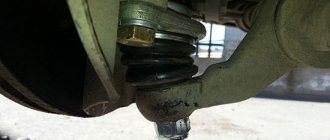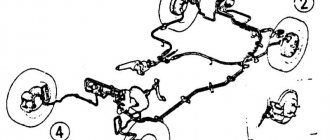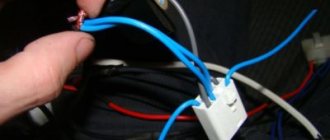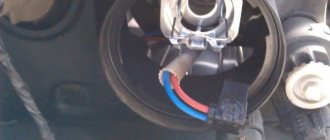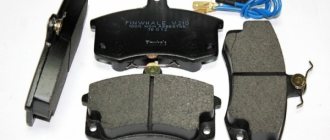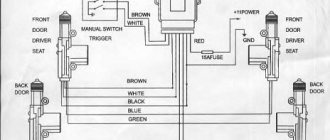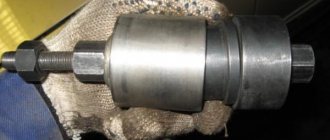Everyone knows such an element of the suspension of a car, and in particular the VAZ 2109, as a shock absorber. Due to the large number of potholes and uneven surfaces on our roads, shock absorbers on cars wear out faster than their Western “colleagues”, which means that the time for replacing them will come sooner. Usually, on our cars, shock absorbers have to be changed every 40,000 km, maybe a little less often or more often, depending on your specific case and the quality of the parts themselves.
A little about the design of automobile shock absorbers, also called struts.
Shock absorbers according to the internal structure are single-tube and double-tube. A monotube shock absorber does not need to be pumped, since area “F”, filled with high-pressure gas, is separated by a sealed piston “E”, through which oil cannot enter area “D”.
Unlike single-tube shock absorbers, double-tube shock absorbers need to be pumped before installing them on a car. A double-pipe shock absorber that is not pumped or is not properly pumped and installed often fails due to the fact that air (or low pressure gas, if the shock absorber is gas-oil) enters its inner sleeve “E” from area “B” through valve “C” when transporting the shock absorber in a position other than vertical.
This leads to noise, knocking during operation of the shock absorber, destruction of its throttle valve, and further to its accelerated failure, and this case will most likely be considered non-warranty. And even if they don’t admit it, replacing shock absorbers also requires either money or time if you do it yourself.
Let's look at how to properly pump new shock absorbers before installing them on a car.
Rear struts VAZ 2109 (oil):
- Turn the stand over to the stem down position and wait 2..3 seconds. and gently squeeze it.
- Hold the shock absorber in this position for 3...5 seconds.
- We turn the stand in a compressed state to the position with the rod up, hold it for 5 seconds, then smoothly pull out the rod.
- We repeat steps 1 – 3 approximately 5...7 times, stopping at step 3 when finished.
Front load-bearing struts VAZ 2109 (gas-oil):
- Set the shock absorber to the rod-up position and wait 2..3 seconds. and smoothly compress it, but not completely, leaving 2-3 cm of movement.
- Hold the stand in this position for 3...5 seconds. then smoothly pull out the rod.
- We repeat steps 1 – 2 several times, stopping at step 2 when finished.
As you can see, in contrast to purely oil shock absorbers, gas-oil shock absorbers are pumped only in the rod-up position.
Further, before installation on the car, the shock absorber must only be in the position with the rod up!
We check the smooth movement of the rod; it should move smoothly without noticeable dips throughout the entire operating range. If, during inspection, bubbling sounds are heard in the rack, it means that not all the air has left the working area “E”, and the bleeding operations should be repeated.
You can replace any part related to the chassis of the vehicle yourself, or contact a specialized service center. Shock absorbers are no exception, but you need to be prepared when replacing them yourself. This article discusses how to pump shock absorbers and why this is done. The features of this process and other interesting things are also described.
ATTENTION! A completely simple way to reduce fuel consumption has been found! Don't believe me? An auto mechanic with 15 years of experience also didn’t believe it until he tried it. And now he saves 35,000 rubles a year on gasoline! Read more"
Do I need to bleed shock absorbers before installation?
Gas remaining in the shock absorber, like air, is a common cause of knocks and noises during chassis operation. Therefore, it definitely needs to be pumped. If the requirement is not met, extraneous knocking and noise appears during the first ten thousand kilometers, which only intensifies over time. The suspension will begin to function with minor dips. “Death” marks jamming.
Do I need to bleed the struts before installation? Necessarily. Otherwise, the shock absorber rod, like the piston system in general, will not be able to fully perform its assigned tasks. At best, you will have to buy a new set of struts; at worst, this will lead to a traffic accident.
The shock absorber is stored in a warehouse in a horizontal position. This is due to the need to maintain the performance of the oil seals through constant contact with the lubricant. Long-term storage leads to spontaneous flow of liquid into the outer cylinder, and the freed volume is filled with air. The result is a partial loss of performance. That is why the driver needs to bleed the strut with his own hands.
Bleeding rear shock absorbers before installation
Bleeding is an easy procedure; new shock absorbers do not need to be sent to a service center. To properly pump the device, you need to follow this sequence of actions.
- Install the stand with the stem down. The base must be solid, ideally a concrete floor.
- Smoothly compress the product.
- We fix the position for two seconds.
- To get the rod back, you need to turn the shock absorber over and pull the tube out manually. Usually the rod rises without outside help.
- Leave the rod in the extended position.
- We repeat the procedure two or three more times.
After this, the rear struts can be installed on the lever or axle of the car.
Oil shock absorbers, bleeding before installation, step-by-step instructions
Having studied the basic rules for pumping a twin-pipe shock absorber, you can proceed directly to this procedure:
- Initially, the shock absorber must be turned so that its rod is at the bottom;
- Having turned the shock absorber over, you now need to compress it with a smooth, uniform movement;
- Hold it for 2-4 seconds and release it. Everything should return to its original position (if this does not happen, then the shock absorber is faulty);
- Pumping must be repeated several times (5-7 times, in this situation, the more pumping, the better);
- Having completed the pumping process, the shock absorber can be installed, but under no circumstances should it be turned over; it should be in the position with the rod up until installation.
How to bleed an oil shock absorber before installation
As mentioned earlier, everything, including oil shock absorbers, must be pre-bleeded before installation. The operating instructions supplied by the manufacturer indicate the correct sequence of actions.
- Vertical placement of the rack, the rod should be in the upper part.
- Recess the rod into the cylinder using little effort (your own weight is enough). You should leave a margin of three to four centimeters above the cut.
- Fix the device in the obtained position for four to five seconds.
- Smooth extension of the rod from the cylinder.
- Repeatedly turn the rack into a vertical position, pumping three or four times according to a similar principle.
That's all, the oil shock absorber can be installed on the car. According to my own observations, pumping automobile oil shock absorbers has the simplest principle.
Bleeding gas-oil shock absorbers
Bleeding automobile gas-oil shock absorbers has a different preparation technology that allows you to bring the device into working condition.
- Place the device in a vertical position, the rod must be at the bottom and must rest against a flat surface.
- By applying a little force, you need to compress the stand without jerking.
- Fixation in the obtained position for two to three seconds.
- Reversing the shock absorber. Important - under no circumstances should the rod be released for three to six seconds.
- Release of the rod.
Leveling errors
To perform this procedure correctly, you must follow the manufacturer's instructions strictly. For example, some manufacturers recommend draining some of the oil from the working cylinder before doing this. It is important that after this procedure the racks must be stored exclusively in a vertical position. The main thing is to avoid mistakes that could affect the performance of the device.
Squeeze all the way
The most important mistake is sudden movements and bringing the piston to a dead point.
To carry out this procedure:
- You need to extend the rod three-quarters of the full stroke. On the other hand, if the product is in a free state, then, on the contrary, you need to retract the rod by 25% of its length.
- After this, turn it over with the rod down and smoothly compress the device without bringing the piston to a dead center.
- It is important that the rod protrudes from the rack pipe by no less than 50-70 mm.
- Without releasing the rod, turn the shock absorber 180 degrees.
- After 3-5 seconds, extend the rod to 75% free play.
- Repeat the compression and release procedure 4-6 times.
Tilts during pumping and after
When performing this procedure, it is important to keep the shock absorber strictly vertical. It is allowed to tilt the device only briefly, but it is better to try not to do this. It is better to perform such actions immediately before installation. It is important to remember that after bleeding the stand should only be in a vertical position.
Bleeding gas shock absorbers
The main working substance inside the piston is gas. Drivers often ask how to properly prepare gas shock absorbers for installation. Answer: no, the need for preliminary preparation is not provided for by the manufacturers. And this is despite the comments of “experts” on the Internet.
Why is that? There is a floating impenetrable piston inside, which is responsible for separating the working environment. It is under constant “calm pressure”, which does not allow the gaseous substance to pass into the second chamber. Triggering occurs when the load on the suspension increases - for example, when a wheel suddenly falls into a hole on the road. Therefore, pumping of automobile gas shock absorbers is not necessary.
Zheka147 › Blog › Bleeding shock absorbers: step-by-step instructions
Varieties If a car enthusiast knows what shock absorbers he knows, then we will get something like this: oil, gas-oil and gas. This answer is partially correct. It is more correct to divide into two types: oil and gas. This division is based on the use of different working substances. Gas shock absorbers use an inert gas, most often nitrogen, pumped under high pressure. In oil shock absorber struts, hydraulic oil and air or gas are pumped into the working space. Structurally, they are divided into two types: two-pipe and single-pipe. The first type of shock-absorbing struts is the most common due to its simplicity and low cost of manufacture. Oil or gas and oil are used as the working substance. The main disadvantage of oil shock absorbers is poor cooling of the working substance. The oil gets very hot due to its small working volume. High temperatures cause the oil to foam and the shock absorber stops working correctly.
Gas-oil shock absorber struts are partially free of this drawback. Oil and air are pumped into a two-pipe housing under a pressure of 2–3 atmospheres. Sometimes nitrogen is used instead of air. This solution reduces the likelihood of aeration - foaming of the oil. Structurally, monotube shock absorbers do not have a working chamber. It is replaced by the rack housing. The tube is divided into two sections. The upper part is filled with oil, and the lower part is filled with high pressure gas. There is a valve between the sections. Gas shock absorbers are of particular interest to drivers. This is no accident. Gas struts are primarily used in motorsports. For sports driving, this type of rack is most often chosen. The operation of the gas shock absorber is ensured by pumped gas under high pressure. Such racks are the toughest and driving on city roads is accompanied by shocks and impacts. Such a ride cannot be called comfortable, but driving will be clear and controlled. Therefore, gas shock absorber struts are used mainly on racing cars. A special type of shock absorbers are the so-called “reversals”. They were given this name not because they can be placed upside down. In such racks, the reverse position of the rod is used. In conventional shock absorbers, the rod is directed upward. In inversions, the rod is directed downwards and is attached to the shock-absorbing strut body. There is a pseudo-rod on top. It looks much thicker. The operation of the inverted shock absorber is ensured by several plain bearings. This design reduces the vertical and lateral load on the rack. Bleeding shock absorbers: rules and recommendations Bleeding oil and gas-oil struts is carried out in different ways. Some manufacturers, for example Kayaba (KYB), have developed their own recommendations; they are usually included in the packaging box and must be on the manufacturer’s official website. There are no significant differences. But there are general rules that must be followed. General details The shock absorbers can only be rocked in a vertical position. Pumping is performed smoothly, without using force. Do not drive the rod with a hammer. If it does not move, then the rack may be faulty or there is another reason - for example, lack of oil in the rack. After bleeding, avoid horizontal position of the shock absorber. Before installing it on the vehicle, keep the rack with the stem facing up. Avoid turning the rod in the shock absorber housing. It is fixed with a special tool. Do not use pliers or a wrench. Bleeding the oil To bleed the oil shock absorber, do the following:
What happens if you don’t bleed the shock absorber before installation?
The procedure discussed is necessary to put the shock absorber strut into working condition. This provides:
- comprehensive removal of residual lubricant or air from the space of the inner sleeve. Failure to follow this procedure will lead to failure of the shock absorber unit after 10-15 thousand kilometers (sometimes earlier);
- early detection of defects and potential malfunctions in box shock absorbers, expressed in the form of sticking of the valve block.
Note! According to the experts who service the suspension at service centers, it is enough to pump the unpacked shock absorber three times. In their opinion, a one-time pumping is not enough to bring the part back to life.
When installing a new shock absorber without preliminary pumping, after 3-5 thousand kilometers, an incomprehensible noise and knocking will occur. After another 5-7 thousand kilometers the strut will jam. It is unlikely that it will be possible to return it to good condition.
Let us inform inexperienced drivers: only twin-tube shock absorbers require bleeding. The exception is a single-pipe new copy. The operating principle is designed so that the oil does not enter the gas chamber, because the latter is under high pressure. The result is that excess air cannot accumulate. A sealed piston is responsible for this, separating the two media from each other.
If you accidentally pump a single-pipe product, it will not damage it. Young owners who do not understand the difference between a single-pipe and a two-pipe device should still do control pumping. On the one hand, this will not harm the single-pipe design. On the other hand, this will take at most five minutes of free time, and it will be possible to avoid potential malfunctions in the future.
Bleeding is a simple procedure that does not require contacting a service station technician. By following the rules, the device will last its entire operational life.
Varieties If a car enthusiast knows what shock absorbers he knows, then we will get something like this: oil, gas-oil and gas. This answer is partially correct. It is more correct to divide into two types: oil and gas. This division is based on the use of different working substances. Gas shock absorbers use an inert gas, most often nitrogen, pumped under high pressure. In oil shock absorber struts, hydraulic oil and air or gas are pumped into the working space. Structurally, they are divided into two types: two-pipe and single-pipe. The first type of shock-absorbing struts is the most common due to its simplicity and low cost of manufacture. Oil or gas and oil are used as the working substance. The main disadvantage of oil shock absorbers is poor cooling of the working substance. The oil gets very hot due to its small working volume. High temperatures cause the oil to foam and the shock absorber stops working correctly.
Gas-oil shock absorber struts are partially free of this drawback. Oil and air are pumped into a two-pipe housing under a pressure of 2–3 atmospheres. Sometimes nitrogen is used instead of air. This solution reduces the likelihood of aeration - foaming of the oil. Structurally, monotube shock absorbers do not have a working chamber. It is replaced by the rack housing. The tube is divided into two sections. The upper part is filled with oil, and the lower part is filled with high pressure gas. There is a valve between the sections. Gas shock absorbers are of particular interest to drivers. This is no accident. Gas struts are primarily used in motorsports. For sports driving, this type of rack is most often chosen. The operation of the gas shock absorber is ensured by pumped gas under high pressure. Such racks are the toughest and driving on city roads is accompanied by shocks and impacts. Such a ride cannot be called comfortable, but driving will be clear and controlled. Therefore, gas shock absorber struts are used mainly on racing cars. A special type of shock absorbers are the so-called “reversals”. They were given this name not because they can be placed upside down. In such racks, the reverse position of the rod is used. In conventional shock absorbers, the rod is directed upward. In inversions, the rod is directed downwards and is attached to the shock-absorbing strut body. There is a pseudo-rod on top. It looks much thicker. The operation of the inverted shock absorber is ensured by several plain bearings. This design reduces the vertical and lateral load on the rack. Bleeding shock absorbers: rules and recommendations Bleeding oil and gas-oil struts is carried out in different ways. Some manufacturers, for example Kayaba (KYB), have developed their own recommendations; they are usually included in the packaging box and must be on the manufacturer’s official website. There are no significant differences. But there are general rules that must be followed. General details The shock absorbers can only be rocked in a vertical position. Pumping is performed smoothly, without using force. Do not drive the rod with a hammer. If it does not move, then the rack may be faulty or there is another reason - for example, lack of oil in the rack. After bleeding, avoid horizontal position of the shock absorber. Before installing it on the vehicle, keep the rack with the stem facing up. Avoid turning the rod in the shock absorber housing. It is fixed with a special tool. Do not use pliers or a wrench. Bleeding the oil To bleed the oil shock absorber, do the following:
How to bleed shock absorbers: rules and technology for pumping oil shock absorbers
The content of the article:
Hello, dear car enthusiasts! Do you know the difference between a good auto shop and a bad one? A naive question, but for many car enthusiasts, the question that the seller asks when buying shock absorbers saves money.
And this question is simple and unpretentious. Will you install the shock absorbers yourself or will they be installed at a service station? - This is exactly what a sales consultant asks in a good car shop.
If you answer that you will install the shock absorbers yourself, then the seller will give you a long “instruction sheet” on how to properly bleed the shock absorber before installing it on the car.
Well, if the installation is carried out at a service station, then the technician will know how to bleed the shock absorbers. But, you should also know that bleeding shock absorbers is a mandatory procedure, and, naturally, have an idea of how to properly bleed a shock absorber.
Why is it necessary to pump shock absorbers before installation?
Bleeding and assembling shock absorbers
Let's start with the fact that if a standard twin-pipe shock absorber is not pumped before installation on a car, this can serve as almost the main reason for the failure of the piston shock absorber. And, in this case, the product warranty will not apply. That is, your money will be lost.
Pumping of oil shock absorbers is carried out in order to bring it into working condition, namely:
- so that air (pressure gas) or oil does not remain in the inner sleeve of the shock absorber, which leads to a malfunction of the shock absorber;
- detect possible jamming of the shock absorber valve mechanism, or any other malfunctions;
You should be aware that if there are not very significant dips in the resistance of the valve mechanism or a slight difference in the speed of the rod exit in the gas-oil shock absorber, this is not considered a malfunction. Such deviations do not affect the overall performance of the shock absorber.
General rules for bleeding shock absorbers
- shock absorbers are pumped in the rod position up, that is, vertically;
- after you have pumped the shock absorber, it must be kept with the rod up, in a vertical position, until it is installed on the car;
- Some shock absorber designs include a mechanism for draining oil. Methods: either by sinking the rod into the shock absorber, or by using a technological groove located at the top of the rod. In the first case, the shock absorber rod should be left uncompressed by 2-3 cm. In the second case, the rod is compressed to the technological groove on it.
How to properly pump oil shock absorbers
MacPherson struts and cartridge struts are typical for modern cars. That is why, using their example, we will consider the technology of pumping the shock absorber.
- We turn the shock absorber down with the rod and without jerking, smoothly compress it;
- Fix the shock absorber in this position for 2-3 seconds;
- Holding the shock absorber rod, turn it upside down and fix it in this position for 3-6 seconds;
- Then, until the end of the stroke, we smoothly extend the rod;
- We turn the shock absorber over again with the rod down, pause for 2-3 seconds and repeat the operation. The number of approaches can be from one to six.
During the third pumping approach, it is necessary to carry out a control action, namely: the shock absorber is in the position with the rod up, with sharp, short movements we make sure that the rod moves smoothly. The piston movement should be smooth, without failures.
If everything is in order and the movement of the shock absorber rod is smooth, then bleeding of the shock absorber is completed and it can be installed in place. We perform similar bleeding operations with other shock absorbers before installation on the car. It is not necessary, but it is recommended to change shock absorbers in pairs, that is, on one axis at the same time.
Why is pumping done?
Not everyone understands why pumping is done and whether it is necessary at all. Some clarity should be provided on this score in order to finally understand the meaning of pumping and the urgent need for such a procedure.
The working mechanisms of shock absorbers include special sleeves in their design. If air gets inside them, then the device will not be able to return to its original position. Moreover, before installation, air must be removed from new and old parts if you suddenly bought used shock absorbers because their price turned out to be lower. It cannot be ruled out that during the suspension repair process or during troubleshooting, air penetrated inside the mechanism.
During storage and transportation, the oil included in the shock absorber penetrates the outer cylinder of the structure, which is why the gas ends up inside the system. This phenomenon leads to the fact that after installing even a new part, a knock is heard.
By performing special actions, excess air is removed from the cylinder. This is done immediately before installation.
And it is still relevant to ask why this is being done. Everything is extremely simple. To ensure correct, efficient and long-term operation of new shock absorbers installed as part of a dependent or independent suspension.
Important nuances of proper pumping
Currently, an impressive number of different automotive shock absorbers are sold, including:
- Kayaba;
- Monroe;
- Phoenix;
- Demfi;
- Bosch;
- Sachs;
- SS20, installed mainly on VAZ;
- Febi;
- Boge;
- ASM;
- Delphi;
- RTS, etc.
In reality, bleeding shock absorbers yourself is not that difficult. You just need to know about some basic nuances, general recommendations, and also take into account the type of part. Each variety has its own special instructions. You can easily emphasize a lot from the video tutorial on leveling up.
Often, you don’t even need a special tool. The main thing is to have gloves at your disposal to prevent damage to your hands and also to protect yourself from contamination.
As for the general rules, they are approximately the following:
- After bleeding and immediately until installation, the shock absorber should be kept strictly in a vertical position;
- If you turn the element over, air will get inside again;
- Some shock absorbers require draining the oil;
- The bleeding procedure largely depends on the type of part used;
- The oil can be drained by dropping the piston into the lower part of the structure, without pressing about 30 mm;
- An alternative option is to use a special groove provided by the manufacturer.
Bleeding the shock absorber, what are the rules for pumping?
There are three basic, unshakable rules for pumping a two-pipe automobile shock absorber:
- The twin-pipe shock absorber is pumped in the rod-up position;
- After pumping the shock absorber, it is not allowed to turn it over to any position. The shock absorber must remain with the rod up until the moment of its immediate installation;
- When compressing, it should be borne in mind that it is highly not recommended to fully compress the shock absorber, since in some of the shock absorbers the oil is drained during full compression. Typically, twin-pipe shock absorbers have special technological grooves along which compression occurs. If they are absent, the compression is not completed to the end of 2-3 millimeters.
To carry out the procedure for pumping a two-pipe shock absorber, there is no need for any tools or special equipment. Bleeding the shock absorber is done purely by hand.
Pumpable types of shock absorbers
Surely you know that shock absorbers are divided into oil, gas and gas-oil. All of them are quite actively used in the design of vehicles.
In this case, pumping is required for all categories of suspension units:
- front shock absorbers;
- rear;
- new parts;
- used;
- original;
- analog;
- single-pipe;
- two-pipe;
- collapsible;
- non-separable.
As you can see, it doesn’t matter what kind of shock absorbers we are talking about. All of them are subject to preliminary pumping before installation. Let you have at your disposal an ordinary old Gazelle or a brand new Audi. Although owners of expensive cars often prefer to have their car serviced at a car service center. But that’s not about that now.
Although it is not fundamentally important whether the shock absorbers are rear and new, or front and used, special attention should be paid to the specific type of element. Gas, oil and gas-oil shock absorbers have their own instructions. Relying on them, you can pump the part with your own hands, and the rack will work for a long time, efficiently and effectively.
Gas shock absorbers
Let's start with pumping these particular shock absorbers. The gas most often used here is nitrogen. It's not difficult to upgrade them. You just need to follow a certain sequence of actions:
- Turn the assembly over so that the rod is pointing down toward the floor;
- Now slowly begin to compress the shock absorber;
- After squeezing, hold it in this position for a few seconds;
- Then turn the part the other way around;
- Hold the rod clamped for 4-5 seconds;
- Pull the rod back until it stops;
- Turn the shock absorber over;
- Leave the element in a horizontal position and install it on the car.
At this point, pumping is considered complete. Like I said, nothing complicated. Take your time, but also try not to keep gas-type shock absorbers in a compressed state for more than 6 seconds.
Oil shock absorbers
In the case of such car shock absorbers, the procedure is somewhat different. It is extremely important to strictly follow the given algorithm. The more accurately you follow the instructions, the higher the likelihood of doing everything as correctly as possible.
- Place the shock with the rod down, as in the case of gas elements;
- Smoothly compress the shock absorber until it stops;
- Having completed the compression, do not release the part and hold for 2-3 seconds;
- Without releasing the rod, turn the shock absorber over;
- Hold in a compressed state for up to 6 seconds;
- At this time, the air should come out;
- Then pull the rod out all the way;
- Turn the shock upside down;
- Wait about 3 seconds, and perform similar manipulations at least 3 times.
Although it is believed that the optimal number of such approaches for oil-based automobile shock absorbers is 6.
When you reach the third pumping, be sure to perform the so-called control action. It consists of the following:
- turn the shock absorber so that the rod points upward;
- make several short but sharp compressions of the rod.
In this case, the movement of a properly pumped shock absorber must be as smooth as possible, without dips or jerks. If this occurs, you need to repeat the pumping procedure.
Gas-oil
If you have not had any problems checking the shock absorbers for performance, then you can easily cope with this task with your own hands.
Gas-oil elements must be pumped immediately before installation. There is virtually no point in doing such a procedure in advance.
- Turn the stand over so that the cylinder is facing up;
- Compress the shock absorber and hold it in the compressed position for 3-4 seconds;
- Turn the element over without releasing the part;
- Slowly and gradually begin to extend the cylinder to its starting position;
- Repeat the same procedure at least 3-4 times;
- Between approaches there is a break of just a few seconds;
- Do not turn the shock over after bleeding is complete.
If you accidentally drop or overturn an already pumped gas-oil shock absorber, you cannot install it on the car. First, be sure to repeat the previous prevention and preparation.
When for some reason you are unable to bleed the shock absorbers, you are not confident in your abilities, or you feel extraneous sounds coming from the suspension after replacing parts, it is better to seek help from qualified specialists.
I think we can end here. If you have questions, be sure to ask them in the comments. And also share your personal experience on pumping shock absorbers yourself. Perhaps you can give some practical advice.
Thank you for your attention! Subscribe, leave reviews, invite your friends and acquaintances to join us!
(
3 ratings, average: 5.00 out of 5)
Did you like the article?
Subscribe to updates and receive articles by email!
We guarantee: no spam, only new articles once a week!
Bleeding gas-oil shock absorbers:
- Turn the strut over so that the cylinder is on top and fully compress the shock absorber;
- Keep it compressed for a few seconds;
- Then turn the shock absorber over to the other side, but keep it compressed;
- Do not pull the rod out of the cylinder very quickly until it is completely restored to its original form;
- Repeat this operation several times (3-4), with short breaks (a few seconds). As in the previous case, do not apply much force when pumping.
After completing all these procedures, try not to turn or lay down the shock absorber, but install it on the car in the same position as it was.
Once you have pumped the shock absorber, it should work perfectly. Nothing should knock, wipe, and so on. When you press on the body, a slight slurping sound may be heard. If you fail to bleed the shock absorber the first time, don’t despair and try again. Taking into account that you are not an expert in this matter, this is typical. Repeat the bleeding procedure every 2-3 years and your shock absorber will give you the best performance it can. If you were unable to bleed the shock absorber yourself, take it to professionals who have already encountered problems of this kind more than once. They must have the appropriate tools, oil and everything necessary for this task.
We have shown only two examples of pumping shock absorbers, but there are other options. Only the most common ones are shown here. If none of ours suits you, look somewhere on the Internet. It is advisable to try, suffer, but do everything yourself. Experience in this matter will not hurt any car owner. It’s not an option to always take it to a service center for any breakdown and pay money. And such skills can lead to the fact that you open your own car service and can make money from it. By opening a business, you will not only earn money, but you will also learn how to fix all sorts of breakdowns yourself.
